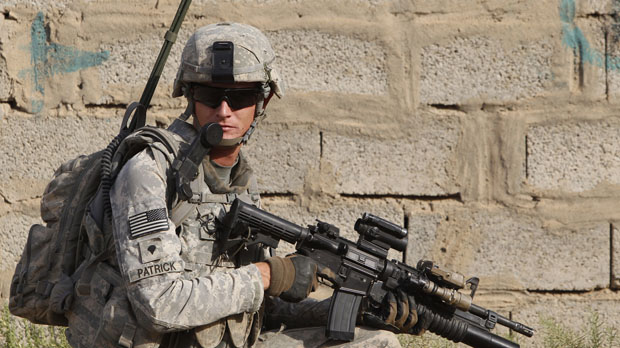US soldiers returning from Iraq and Afghanistan with an apparently untreatable and incurable lung disease are being dismissed as out of shape because tests appear normal, writes Sarah Jones.
Dr Robert Miller, of Vanderbilt University, says: "This scarring of the small airways in the lungs is common in people who have had bone marrow transplants or lung transplant rejection not people who have passed military fitness exams.
"What we can say is that this disorder is linked to service in the Middle East. But we haven't been able to definitively link what the cause is for the black lacy pigment. It's something that's inhaled that shouldn't be there."I get shortness of breath and painful burning in my lungs after running just a quarter of a mile, I can't run any more Dr Sylvia Waters
Last month the New England Journal of Medicine published a study by Dr Miller and colleagues which documented the condition of soldiers who had served in Iraq and Afghanistan and were diagnosed with constrictive bronchiolitis.
However, their analysis doesn't reveal how common the condition is in troops or positively identify the cause of constrictive bronchiolitis in troops.
'Black lacy pigmentation'
The diagnoses were made after lung biopsies. At least half the soldiers have left the service with a disability rating making them eligible to receive anywhere between $123 to over $3,100 per month depending on the level of their disability and number of dependents.
 In certain instances the Department of Veterans Affairs recognises a link between the disorder and service. But compensation is based on pulmonary function testing (PFT) and soldiers with constrictive bronchiolitis have normal PFT results despite having scarring of the airways, black lacy pigment in their lungs and severe exercise limitations.
In certain instances the Department of Veterans Affairs recognises a link between the disorder and service. But compensation is based on pulmonary function testing (PFT) and soldiers with constrictive bronchiolitis have normal PFT results despite having scarring of the airways, black lacy pigment in their lungs and severe exercise limitations.A further complication is that deployed troops do not receive pre- and post-deployment pulmonary function tests that could help doctors know the extent of lung damage.
Dr Sylvia Waters serves in the US army and is a practicing anaesthetist. She used to run every day but after serving in Iraq she had to give up her passion.
"After a six-month tour in Mosul, Iraq I get shortness of breath and an excruciating burning in my lungs after running just a quarter of a mile. I can't run any more."
Army physicians tried routine tests including X-rays, pulmonary function tests and chest CT scans. They tried inhalers and steroid treatments but nothing worked and all tests results kept coming back normal.
At times, Dr Waters says she doubted herself: "I felt like I was going crazy because all these physicians kept telling me everything was coming back negative.
"It was only the fact that I was a physician and I knew other doctors that I even got diagnosed because I don't know how else I would have done it."
Dr Waters' diagnosis process involved an invasive procedure in which the chest is cut open so that a small piece of the lung can be removed for analysis.
"The procedure provided me with an answer, and although it's invasive there was a chance I could have been diagnosed with something treatable. The diagnosis was shocking because, if it's progressive, people live five to 10 years but at the same time I was relieved to finally have an answer."
Although the military referred Dr Waters to Dr Miller at her request, Dr Miller says the Department of Defense stopped sending soldiers to him three years ago.
When asked why they had stopped referring patients to him, the Department of Defense issued a statement saying despite this, it is still committed to investigating respiratory health risks.
Craig Postlewaite, Director of Force Readiness, Health Assurance, Health Protection and Readiness Programs said that the Department continues to collect medical surveillance data and perform epidemiological studies to evaluate health risks associated with breathing dust or smoke.
Dr Waters says the year-long journey to get diagnosed was arduous even though she's a health professional.
"There is no way a typical Private would get to see Dr Miller, because they don't know what to research. They're being told by a physician 'you're normal, everything's fine, go suck it up and run' but then they fail their physical fitness test.
"These are young kids, 18 years old, they have no clue. I found it was difficult even for me to get diagnosed and I'm a physician."
Source: http://www.channel4.com/news
When asked why they had stopped referring patients to him, the Department of Defense issued a statement saying despite this, it is still committed to investigating respiratory health risks.
Craig Postlewaite, Director of Force Readiness, Health Assurance, Health Protection and Readiness Programs said that the Department continues to collect medical surveillance data and perform epidemiological studies to evaluate health risks associated with breathing dust or smoke.
Dr Waters says the year-long journey to get diagnosed was arduous even though she's a health professional.
"There is no way a typical Private would get to see Dr Miller, because they don't know what to research. They're being told by a physician 'you're normal, everything's fine, go suck it up and run' but then they fail their physical fitness test.
"These are young kids, 18 years old, they have no clue. I found it was difficult even for me to get diagnosed and I'm a physician."
Source: http://www.channel4.com/news


No comments:
Post a Comment